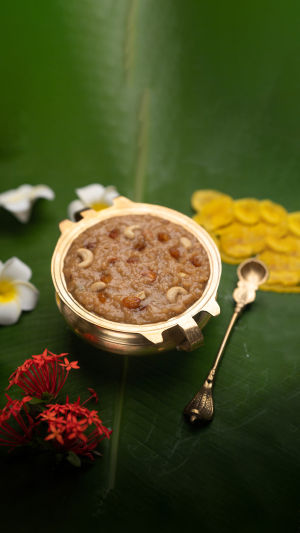Welcome Lykkers! Have you ever had the chance to try the succulent Payasam (also known as "kheer" in North India)? It is a popular South Indian dessert traditionally made for festivals, weddings, and celebrations.
This sweet dish has deep cultural roots across South India, with variations in Tamil Nadu, Kerala, Karnataka, and Andhra Pradesh.
The main ingredients generally include rice or vermicelli, milk or coconut milk, sweetened with jaggery or sugar, and flavored with cardamom, saffron, and garnished with cashews and raisins.
The word payasam used in South India originates from the Sanskrit term pāyasa (पायस), which means "milk" or a dish made from milk. This term evolved into various regional languages, including Malayalam (പായസം, pāyasaṁ), Telugu (పాయసం, pāyasaṁ), and Tamil (பாயசம்,pāyacam).
Payasam Recipe - How To Make South Indian Kheer - Indian Sweet Recipe - Varun - Rajshri Food
Video by Rajshri Food
<h3>Origin of Payasam</h3>
It was said to have originated 1000 years ago initially in South India. There is a story titled "The Legend of Chessboard" in Kerala and this captivating tale involves the king of Ambalapuzha, known for his love of chess. One day, a mysterious sage—revealed later as Lord Krishna—challenged this chess-loving king to a game. As a prize, the king offered anything the sage desired. The sage, appearing humble, asked only for a few grains of rice, adding one clever condition: The rice should be placed on the chessboard in a specific way—one grain on the first square, then doubled on each subsequent square.
The king agreed, but as the grains accumulated, the seemingly simple reward grew at an astronomical rate. By the time he reached the 64th square, the king was overwhelmed by the trillions of grains required. It was then that the sage revealed his divine identity as Lord Krishna and made a compassionate request: rather than fulfilling this impossible prize, the king should provide sweet rice pudding, or "payasam," to any devotees visiting his temple.
To this day, Ambalapuzha Krishna Temple in Kerala's Alappuzha district serves this dish, honoring the promise. Historically, payasam (known as "kheer" in North India) has long been cherished across India. Food historian K.T. Achaya notes that this mixture of rice, milk, and sugar dates back over two thousand years, first mentioned in ancient Indian texts. Payasam holds special significance in Hindu temples, serving as "prasāda," or a blessed offering to devotees, connecting the dish to both cultural heritage and spiritual tradition.
<h3>Key Varieties of Payasam</h3>
<b>1. Rice Payasam (Akkaravadisal):</b> Made with rice, milk, and jaggery, rice Payasam is a creamy, rich dessert. It's often cooked slowly to enhance its texture and flavor, sometimes including ghee for added richness.
<b>2. Vermicelli Payasam (Semiya Payasam):</b> Vermicelli is cooked with milk and sweetened with sugar or condensed milk. It's one of the quickest types to prepare, with a smooth texture and mild taste.
<b>3. Parippu Payasam:</b> This Kerala specialty is made using moong dal (split green gram) with coconut milk and jaggery, giving it a unique earthy flavor. It's a must-have during Kerala's Onam festival.
<b>4. Ada Pradhaman:</b> A Kerala classic made using rice flakes (ada) and coconut milk, flavored with cardamom and jaggery. Ada Pradhaman is rich and decadent, often served in temples and for special occasions.
<b>5. Paal Payasam:</b> This is a basic yet delicious version made simply with rice, milk, and sugar, simmered for hours to achieve a thick, creamy texture. It's often considered a luxurious dessert due to its richness.
<h3>How to Make a Basic Rice Payasam(Paal Payasam)</h3>
This sweet dish is typically made with rice, milk, sugar, or jaggery, and flavored with cardamom. Payasam is popular for festivals and ceremonies, where it's served as a prasad (blessed food) in temples.
<h3>Ingredients</h3>
Rice (1/4 cup, washed and soaked)
Milk (4 cups for a creamy texture)
Sweetener: Sugar or jaggery to taste
Flavorings: 4-5 cardamom pods (crushed), and a pinch of saffron (optional)
Garnish: Cashews, almonds, raisins, and a bit of ghee
<h3>Method</h3>
<b>1. Prepare the Rice:</b> Cook the rice in a pan or pressure cooker with water until it's soft.
<b>2. Add Milk and Sweetener:</b> Add the milk and cook until it thickens, then add sugar or jaggery for sweetness.
<b>3. Flavor and Garnish:</b> Stir in cardamom, and separately sauté cashews and raisins in ghee. Add these to the payasam.
<b>4. Simmer and Serve:</b> Let the payasam simmer until it reaches a creamy consistency, then serve warm or chilled.
For more variations, try adding coconut milk or using moong dal instead of rice for a distinct flavor. There would be lots of different variations in different households. Similarly, we can also prepare Vermicelli Payasam(Semiya Payasam) by following this same recipe and only changing the rice with vermicelli.
<h3>Modern Variations of Payasam</h3>
Nowadays ready-made payasam mix is available everywhere in the market which makes it even easier for people to enjoy it.
In Kerala the variations for payasam keeps on evolving to different varieties of payasam, like adding banana or jackfruit which is common in Kerala.
The diversity and appeal of payasam have therefore been greatly enhanced by South India-specific recipes and ingredients, but it would be more accurate to state that payasam has developed and gained acceptance throughout the Indian subcontinent.





